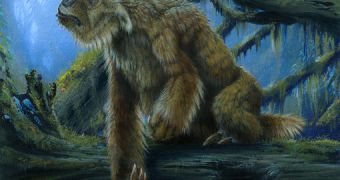In North America there's Bigfoot, while in the Amazon we have the mapinguary, the giant slothlike mysterious monster, triggering shivers down the spines of almost everybody who lives in the Amazonian rain forest. And unlike Bigfoot, this monster has a fossil record. The folk stories abound in encounters with the creature, and nearly all Indian tribes in the Amazon, including without contact with one another, have a denomination for the mapinguary, "the roaring animal" or "the fetid beast." Expeditions have been made trying to discover the creature, but none has succeeded in the task.
"It is quite clear to me that the legend of the mapinguary is based on human contact with the last of the ground sloths, thousands of years ago. We know that extinct species can survive as legends for hundreds of years. But whether such an animal still exists or not is another question, one we can't answer yet," said David Oren, a former director of research at the Goeldi Institute in Bel?m, at the mouth of the Amazon River.
He met a couple of hundred people who mentioned having seen the mapinguary in the most remote parts of the Amazon and a pair who had said they had direct contact with the beast. In some areas, mapinguary is said to have two eyes, in others just one. The monster is depicted as having a stinking mouth in its belly through which it engulfs humans it meets.
But all the stories have something in common: the creature is tall, over 7 ft (2.1 m) when it stands on two legs, it emits a strong, extremely disagreeable odor, and has thick, matted fur, covering a carapace that turns it immune to bullets and arrows. "The only way you can kill a mapinguary is by shooting at its head. But that is hard to do because it has the power to make you dizzy and turn day into night. So the best thing to do if you see one is climb a tree and hide," said Domingos Parintintin, a tribal leader in Amazonas State.
"It was coming toward the village and was making a big noise. It stopped when it got near me, and that's when the bad smell made me dizzy and tired. I fainted, and when I came to, the mapinguary was gone." said Geovaldo Karitiana, 27, a Karitiana Indian, who claims to have met the monster three years ago.
Unlike Bigfoot of North America or the yeti of Himalaya (which has a fossil record, the giant ape Gigantopithecus), mapinguary does not run and hide from humans; instead, it turns aggressive. "Often, the mapinguary gets revenge on people who transgress, who go where they shouldn't go or harvest more animals or plants than they can consume, or set cruel traps," said M?rcio Souza, a prominent Brazilian novelist and playwright who lives in Manaus, in the central Amazon.
"If you're a rubber tapper and you're returning to camp empty-handed, you'd better have a pretty good explanation for your boss. The mapinguary is the best excuse you could possible imagine." said Marcos Vin?cius Neves, director of the government's department of historical and cultural patrimony in Acre State, where there's a statue of a mapinguary in the capital.
Souza thinks the mapinguary is a myth, as the current human contact in the Amazon could have revealed the existence of the creature. "There would have been some sort of close encounter of the third kind by now."
Mapinguary fits the fossils of the giant ground sloth, Megatherium, disappeared just 8,000 years ago, one of the largest mammals to have ever lived on the earth, as big as a modern elephant. They roamed from Chile to as far north as Florida. "When you travel in the Amazon, you are constantly hearing about this animal, especially when you are in contact with indigenous peoples. But convincing scientific proof, in the form of even vestiges of bones, blood or excrement, is always lacking." said Peter Toledo, a sloths expert at the Goeldi Institute.
"I was among the skeptics until 1997, when I was doing research about local wildlife among the Machiguenga people of the far western Amazon, in Peru. Tribal members all mentioned a fearsome slothlike creature that inhabited a hilly, forested area in their territory," said Dr. Glenn Shepard Jr., an American ethnobiologist and anthropologist based in Manaus.
He was surprised when a member of the tribe recognized the mapinguary at the natural history museum in Lima, in a diorama representing Megatherium. "At the very least, what we have here is an ancient remembrance of a giant sloth, like those found in Chile recently, that humans have come into contact with. Let me put it this way: Just because we know that mermaids and sirens are myths doesn't mean that manatees don't exist. There's still an awful lot of room out there for a large sloth to be roaming around," said Shepard.

 14 DAY TRIAL //
14 DAY TRIAL //